Electrical energy is converted into mechanical, thermal, and light energy through electric motors, resistive heating, and different types of bulbs.
Converting Electrical Energy to Other Forms of Energy
Electrical energy is a versatile and easily convertible form of energy. Many devices and appliances are designed to convert electrical energy into other forms of energy to perform various tasks. In this article, we will explore the ways electrical energy is converted into other forms of energy, such as mechanical, thermal, and light energy.
Mechanical Energy
Electrical energy is often converted into mechanical energy to generate motion. This is achieved using devices called electric motors. Electric motors use the principle of electromagnetic induction to create rotational or linear motion. The interaction between the magnetic field created by the electric current and the external magnetic field generates a force, which results in motion. Some common applications of electric motors include:
- Fans
- Washing machines
- Electric vehicles
- Industrial machinery
Thermal Energy
Electrical energy can also be converted into thermal energy or heat. This conversion occurs when electric current flows through a resistive material, generating heat due to the internal resistance of the material. The heating effect of electric current is called Joule heating. Devices that convert electrical energy into thermal energy include:
- Electric heaters
- Electric stoves
- Water heaters
- Hair dryers
Light Energy
Converting electrical energy into light energy is another common application. Various types of light bulbs and lamps are designed to achieve this conversion. The two main types of light bulbs are incandescent and LED (light-emitting diode) bulbs.
Incandescent bulbs work by passing an electric current through a thin filament, which becomes hot and emits light as a result. On the other hand, LED bulbs utilize semiconductor materials to emit light when an electric current flows through them. LEDs are more energy-efficient and longer-lasting than incandescent bulbs.
Conclusion
Electrical energy is a versatile form of energy that can be easily converted into other forms of energy, such as mechanical, thermal, and light energy. This makes it a crucial component of modern society, powering a wide range of devices and appliances that make our lives more convenient and efficient.


